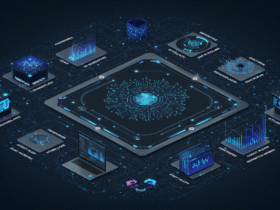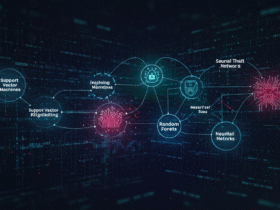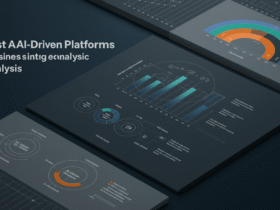With the changing technology, the peril of cyber threats perpetually heightens. The possibility of hacking large tech companies is exceedingly high since they are gold mines of sensitive information, expensive assets that provide cybercriminals with a reason to go after them, not to mention the complexity of their IT infrastructure.
The growing deployment of endpoints-laptops, mobile phones, servers-has essentially increased the attack surface to a great extent and this is why endpoint security is also among the major concerns of cybersecurity. The modern threats are very sophisticated and huge thus traditional security solutions have a hard time keeping up.
It is here that Artificial Intelligence (AI) can incorporate ending security of large businesses to transform the way things are done.
Understanding Endpoint Security and Its Importance
Endpoint security is an act of shielding endpoints (the devices individuals connect to a network) against cyber threats. This involves securing laptops, mobile phones, tablets, servers, workstations and even the Internet of Things (IoT) devices which make contact with the corporate networks. The main objective is to make sure that these devices are not used as entry points by malicious players who are seeking to penetrate the network with the purpose of causing damages.
The Growing Threat Landscape
Over the past years, the threat environment has been changing at a high pace. The newer and more advanced threats (ransomware, phishing attacks and advanced persistent threats (APTs)) have been added to the traditional cyberattacks (virus, worms, and Trojan). The problem is that big technology companies are usually attacked because of the abundance of valuable intellectual property and customer data stored in them.
The endpoint has subsequently exploded and there is now an enormous amount of both endpoints and entry points, with the advent of remote work, the introduction of cloud computing and the proliferation of mobile devices. As a matter of fact, based on recent reports, endpoint attacks represent a very high portion of cyberattacks.
Traditional Endpoint Security Challenges
The conventional endpoint security systems are mostly based on signature detection. This implies that they identify threats that are known by matching files or activity with a malware signature of malicious programs that have been identified. Although signature-based system is useful in combating familiar malware, it is very ineffective when consumers are faced with new or changing malware as well as polymorphic malware that cannot be detected using signature-based systems.
Moreover, the number of false positives generated by these systems usually overwhelms the security teams and has the effect of alert fatigue. Because of this, security teams can miss out on the actual threat in an attempt to sort through an immense number of alerts.
The Need for AI in Endpoint Security
The endpoint security systems powered by AI solve the drawbacks of the usual systems. By using machine learning, behavior analysis and monitoring in Real time, AI finds out both known and unknown threats with a significant increase in detection and false positive reduction. Automation of threats is also possible with AI, which allows the security teams to concentrate on the other tasks and the bigger decisions.
| Traditional Endpoint Security | AI-Powered Endpoint Security | Business Impact |
|---|---|---|
| Signature-based Detection | AI-based Detection using ML and anomaly detection | Identifies both known and unknown threats, reducing vulnerabilities |
| Manual Response | Automated threat response, with AI-powered incident mitigation | Faster response time, reduces human error and intervention |
| High False Positives | Lower false positives through AI’s continuous learning | More accurate threat detection, reducing alert fatigue |
| Limited Scalability | Scalable AI-powered systems that adapt to growing networks | Supports business growth, ensuring security as networks expand |
How AI Enhances Endpoint Security for Large Tech Companies
The use of AI technologies (especially machine learning) is important to enhance endpoint protection dealing with detection, analysis and response to threats much quicker than traditional systems. The following are some of the major ways through which AI can improve endpoint security of large technological firms:
Real-Time Threat Detection
It is possible to use AI systems to analyze traffic and the behaviour of the endpoints in real time. While they are keeping track of whatever happens on the network, they know when there is any suspicious activity. In contrast to the popular signature-based tools, AI does not use known patterns of attacks. Instead, it will present an abnormal behavior which might be an abnormal time of the day or time of log-in, access to restricted parts or unrealistic data transfer which might be a sign of malicious activity.
Example: Suppose that an endpoint begins sending huge amounts of information to an unknown external IP address, an AI-enhanced security system would claim this an irregularity, indicating a possible data exfiltration attempt and may take instantaneous steps in detaching the endpoint.
Behavioral Analytics
The AI-based endpoint security model incorporates behavioral analytics to trace the typical behavior of all devices and users. These behavior continuingly undergo the analysis of the AI models and any deviation that would point to a security breach. This is especially useful in identifying high level threats such as insider threat or stolen credentials that legacy systems may not be able to pick up.
Example: AI is able to recognize when an employee suddenly begins to access protected files that they do not usually access or log into a device or get into a location which was not used earlier and this can be identified by the AI as an attempt to access the data in a malicious manner.
Proactive Threat Prevention
AI is able to recognize when an employee suddenly begins to access protected files that they do not usually access or log into a device or get into a location which was not used earlier and this can be identified by the AI as an attempt to access the data in a malicious manner.
Example: AI can determine the probability of whether a phishing attack on a user will take place using historical data trends and it is therefore able to warn users even before they can access the email links or tap into possible harmful attachments.
Automated Incident Response: The process of Automated Incident Response automates the process of collecting, gathering, and integrating information related to incidents and then storing or recalling that information.
When a possible threat is identified, the threat can be addressed using automations the AI can take right away. As an example, it can quarantine an infected device, deny access to confidential data, and kill malicious processes. The automation can greatly lessen the time used in reaction to the security incidences and this is vital in reducing harm, in the case of a cyberspace attack.
Example: In case of a ransomware, the AI-driven endpoint security tool can automatically isolate the infected endpoints on the network to isolate the malware and contain the ransomware spreading.
| AI Capability | How It Enhances Endpoint Security | Business Benefit |
|---|---|---|
| Real-Time Threat Detection | Detects abnormal behavior and unauthorized access in real time | Provides faster threat identification and response |
| Behavioral Analytics | Monitors and analyzes user and device behavior for anomalies | Detects insider threats and compromised credentials early |
| Proactive Threat Prevention | Predicts and prevents potential attacks using historical data | Strengthens defenses before threats can escalate |
| Automated Incident Response | AI autonomously isolates infected endpoints and blocks threats | Minimizes damage, reduces response times |
Challenges in Implementing AI-Powered Endpoint Security
Although endpoint security powered by AI has a great number of advantages, implementation has its difficulties. And now, to see some of the immediate obstacles organizations run against during the integration of the AI components in endpoint security:
High Initial Costs
The endpoint security solutions based on AI may be very costly, especially when it comes to large organizations that have highly complicated infrastructures. Initial costs of investments are the software, training, and maintenance.
Solution: Big companies will have a chance to reduce expenses as they can consider using the services of AI in the cloud or subscription-based plans that will adjust to the number of requests, distributing their fiscal burden over a period.
Integration with Legacy Systems
Most organizations have legacy security systems that cannot work with contemporary AI-backed tools. Integration may again be complex and time consuming and it needs further resources to make it compatible.
Solution: Select AI security solutions that have APIs and are inclined to integrate with the current infrastructure. Moderated deployment will facilitate the process of integration.
Data Privacy and Compliance
Endpoints security powered by artificial intelligence needs a great deal of data, including possibly sensitive data on customers or employees. The most important factor is ensuring adherence to data privacy laws such as GDPR and HIPAA regulations.
Solution: Introduce data governance procedures, anonymize the sensitive information and make sure the AI security systems are satisfactory to all the applicable regulations.
Lack of Skilled Workforce
Security tools using AI technology have specific knowledge that is needed to implement, configure, and tune. Skilled professionals may not be easy to find and most of them only know about cybersecurity or machine learning.
Solution: Take an investment in training the current IT personnel or the cooperation with AI security consultants to develop the adequate acceptance and management.
| Challenge | How to Overcome It | Business Benefit |
|---|---|---|
| High Initial Costs | Opt for scalable cloud-based solutions or subscription models | Reduces upfront investment, flexible cost structures |
| Integration with Legacy Systems | Use tools designed for easy integration with existing infrastructure | Smooth deployment, minimal disruption |
| Data Privacy & Compliance | Implement strong data governance and privacy policies | Ensures compliance, protects sensitive data |
| Lack of Skilled Workforce | Provide training or hire AI consultants | Better management of AI tools, improved security operations |
The Future of AI in Endpoint Security
With persistent changes in AI technology, its use in endpoint security will become magnified even more. The endpoint security solutions implementing AI will be more autonomous, intelligent, and incorporated with the general security architecture in the following years. The following describes trends of the future that are affecting AI in endpoint security:
Autonomous Threat Detection and Response
First, AI will play a major role in endpoint security in the future as more and more AI systems are going to be able to automatically detect, analyze, and mitigate threats without further human interaction. These systems will be better at detecting even a minute threat as artificial intelligence models continue advancing and this enables more timely and precise counter-reactions.
Example: The example would be that AI will automatically isolate a compromised device, preclude data breaches and correct the situations without waiting on human input.
Integration with Zero Trust Architectures
The enforcement of Zero Trust security models will be of utmost importance based on the use of AI because Zero Trust security models assume that no user or device is inherently trusted. Endpoint security is based on the use of AI that allows continuously checking all activity and data on the devices, detecting users, and actions and denying or granting access on a dynamic score, not a fixed policy of believing or not believing.
Example: AI-based algorithms will determine the degree of risk of any device connecting to the network and configure access level, so that only the trusted entities would be able to interact with the sensitive information.
More Intelligent Threat Hunting
AI will be used more and more as part of threat hunting to scan the depths of data on an endpoint and help see red flags early. AI will actively and proactively find invisible threats and vulnerabilities unlike automated systems that have to sit and wait to be alerted of such.
Example: AI will be more active in endpoint behavior scanning to detect indicators of lateral movement or privilege escalation, which might be early evidence of an attack.k.
Enhanced Privacy-Preserving Security
With an ever-increasing concern about privacy, security with higher privacy levels is going to be based on AI. The models will enable organizations to identify threats without invading or infringing the privacy of the users or breaching data protection laws. Such methods as federated learning and privacy-preserving machine learning will enable AI systems to perform their tasks but without touching on any sensitive data.
Example: The AI will conduct threat analysis of encrypted data without decryption, with the data remaining private but will still find out possible threats.
| Future Trend | Description | Business Benefit |
|---|---|---|
| Autonomous Threat Detection & Response | AI will automatically detect and respond to threats in real-time | Faster threat mitigation, reduced human error |
| Integration with Zero Trust | AI will continuously verify user and device behavior for access control | Stronger security, reduced insider threats |
| More Intelligent Threat Hunting | AI will proactively scan for early signs of suspicious behavior | Early detection of threats, more efficient resource allocation |
| Enhanced Privacy-Preserving Security | AI will perform security analysis without compromising privacy | Protects sensitive data while identifying potential threats |
Summary
Endpoint security through the use of AI is the future of the protection of large tech companies against dynamic changing environment of cyber threats. With the use of machine learning, behavioral analytics and predictive analytics, AI driven solutions offer an end to business endpoint protection protection via the proactive, efficient and scaleable process.
The systems can help identify known and unknown risks, automate the response to incidents, and learn every minute to keep up with the cybercriminals.
Nevertheless, the deployment of AI-driven security systems is linked with some obstacles, such as expensive costs, complexities of integration, and the lack of highly qualified specialists.





























Leave a Reply